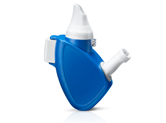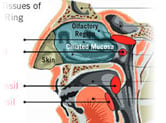Liquid Delivery Device
The liquid Exhalation Delivery System (EDS) consists of a primary drug container for the liquid drug formulation and an amber glass vial which are sealed by a crimp-fitted metering spray pump and enclosed within a proprietary liquid delivery subassembly. The nasal spray applicator, which is a component of the subassembly, is attached to the pump and extends to the top of the nosepiece of the liquid delivery subassembly. The EDS includes a flexible mouthpiece and an asymmetrically shaped nosepiece as part of a mechanism that uses the patient’s exhaled breath to naturally seal closed the soft palate and to facilitate delivery of drug to the nasal passages through the sealing nosepiece. The nosepiece is designed to create a seal with the nostril and also to expand and stent the upper part of the nasal valve, which is an important anatomical structure that is the narrowest part of the entire respiratory tract and a barrier that causes most medication delivered by traditional INS to deposit in the front part of the nose.
An EDS uses Bi-Directional™ delivery:
- The EDS has a flexible mouthpiece and a sealing nosepiece. The nosepiece is shaped to transfer pressure from the mouth, avoid obstruction by compression of soft tissue, and expand the upper part of the nasal valve
- Exhalation through the EDS: 1) creates an airtight seal of the soft-palate, isolating the nose from the mouth and lungs; 2) transfers proportional pressure into the nose; and 3) helps “float” medication around obstructions to deposit in high/deep sites in the nasal passages, such as the ostiomeatal complex (OMC)
- The transferred pressure is proportional to varying exhalation force, counterbalancing pressure on the soft palate. This assures a patent communication behind the nasal septum, allowing air to escape through the opposite nostril. “Positive pressure” expands passages narrowed by inflammation (versus negative pressure delivery, or “sniffing”)
- Use is simple and quick. A patient inserts the nosepiece into one nostril and starts blowing through the mouthpiece. This elevates and seals the soft palate, as with inflating a balloon, separating the oral and nasal cavities. The patient completes use by pressing the bottle to actuate. This causes a coordination-reducing valve to release the exhaled breath concurrently with aerosol spray in a “burst” of naturally humidified air
Watch This Video to See How It Works
In market research, device users demonstrated a clear preference for EDS over traditional nasal sprays.
After 4 weeks of use, advantages include[1]:
- Intuitive and easy to use
- More comfortable due to its fixed position during use
- Airflow through the nose at actuation reduces the discomfort often experienced when the spray is released
- Reduction in the aftertaste at the back of the throat
Reference
[1] Data on file. OptiNose US, Inc.
Powder Delivery Device
 Anatomy of the Nasal Passages
Anatomy of the Nasal Passages
Experience the anatomy of the nasal passages and how it works.
